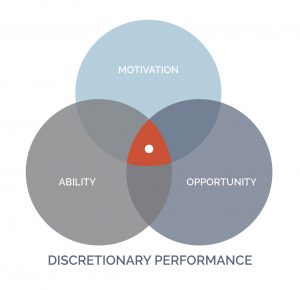May I invite you to read the following quote:
“There is probably no greater waste in industry today than that of willing employees prevented by insensitive leadership from applying their energies and ambitions in the interest of the companies for which they work.”
What do you think? The premise is so simple: Match your employees’ sense of purpose to your company’s needs, let them loose, and they will perform. There is an intrinsic link between the interest of companies (i.e., customer satisfaction) and employee satisfaction. Most employees are looking for meaning in the jobs they perform.
Just as significant is the challenge offered by this quote the year it was made: 1964! This is not some new insight shining light in a newly complex world. It was Pat Haggerty, then President and CEO of Texas Instruments. It definitely attracted me to join the company in 1980 and to stay for 15 years.
Is the Present Really More Complex than the Past?
Albert Einstein said: “Everything should be made as simple as possible, but not simpler!”
So many times it seems that we make things out to be complex. I wonder why. Is the world today really more complex than it used to be? Or does complexity merely present itself in a different way?
I submit that life was just as complex in 1964 as it is today, but the complexity looked different back then. The complexity of interconnectivity didn’t exist to the degree that it does now. But that meant you couldn’t just pick up your iPhone and research something. If you wanted a P&L, you had to write code. That’s a different kind of complexity, but it’s complexity nonetheless.
As another example, we make assumptions about factors impacting employees, especially the emerging young employees. In this context, “digitalization” risks becoming the new buzzword. It is assumed that the younger generation is looking for the highest degree of flexibility in the work environment, exploiting opportunities provided in the digital area. Much energy and effort is spent to provide them as much flexibility as possible. Yet, a very recent study showed that this emerging employee population is actually more interested in stability than flexibility—and, contrary to stereotypes, it‘s even more true in the U.S. than in Europe!*
Don’t get me wrong. I am not suggesting that digitalization is simply a fad. I don’t think it is. What I am saying with my example is that we should reflect more on what motivates this—or any other—employee demographic or individual employee. Whatever their generation, people look for purpose at work. But purpose means different things to different people.
During my many years as a leader in the talent management space, I learnt that three conditions are really important for employees to commit to discretionary performance: Opportunity, Capability, and Motivation. If one of these three conditions is not met, will you get discretionary performance? Most likely not. Simple, isn’t it?
War and Peace
I profoundly dislike terms like “The War for Talent”. Everybody loses in a war. Yet, most firms want to win in the market they participate in. To win, we need employees who apply their energies and ambitions in our company’s interest. What is “our company’s interest”? Ultimately, whether you’re in the retail or B2B sphere, it’s customer satisfaction.
The Employee Value Proposition
The emerging employee base has a choice and its members will exercise the choice whenever they can. To get the right kind of employees to choose your organization, you must articulate an Employee Value Proposition—showing the prospective hires the value they will get from working with you. Hiring people whose underlying motivations align with your organizational goals results in motivated employees. Leaders who then take the lid off of motivated employees, letting them do what they believe they can do best, automatically foster discretionary performance.
That brings us back to the intrinsic link between customer satisfaction and employee satisfaction. It all goes back to the three circles of Opportunity, Capability, and Motivation. The trick is for leadership to maximize the overlap among the three circles for their employees. If you give employees Opportunities to use their natural Capabilities to reach goals tied to their underlying Motivations, you’ll get satisfied employees (who give their best), satisfied customers (who get what they want), and a satisfying bottom line (for you and your investors).
Simple, isn’t it!
*Broadcast by Bayern 5 Aktuell (Bavarian News Radio Channel) of a Study contracted by Allianz Insurance Company conducted in 2017, including Germany, UK, USA, China, and India. Included in the research was a representative sample of 5000 people born between 1982 and 1999. Only 15% stated that they wish to change jobs frequently. In the US sample that number was even lower.
Karl-Heinz Oehler is Managing Partner of Denison Consulting Europe. In future articles, he will describe the link between organizational culture, the employee life cycle, and talent management, and explore the need for leaders to convey Employee Value Proposition to future hires.






